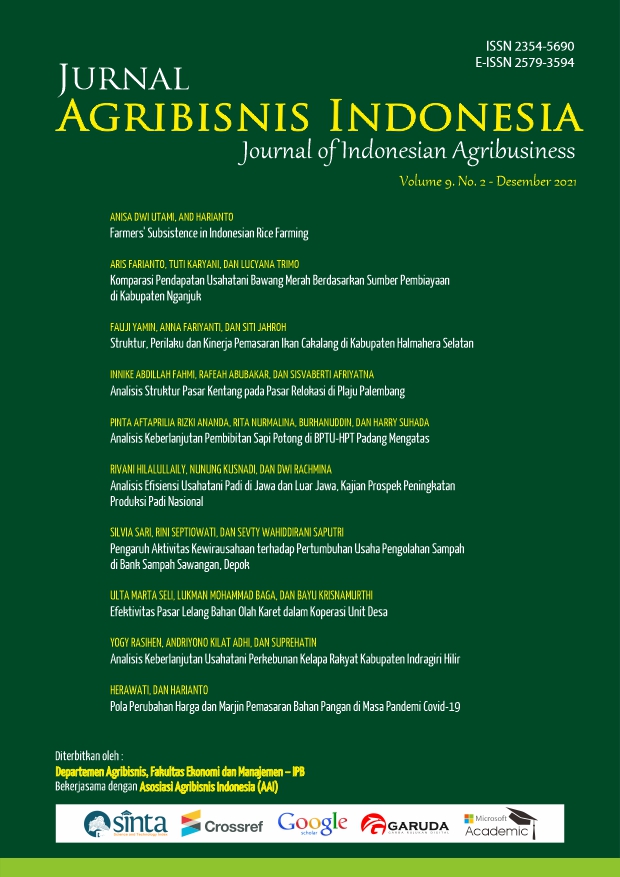Analisis Efisiensi Usahatani Padi di Jawa dan Luar Jawa, Kajian Prospek Peningkatan Produksi Padi Nasional
Main Article Content
Abstract
Rice can grow in almost all of the islands in Indonesia, but 57 per cent of it was produced in Java, which is less than 10 per cent of the national area in Indonesia. To anticipate the increasing need for rice consumption, it is important to study the prospects for increasing national rice production, especially by utilizing the potential of agricultural land outside Java island. The purpose of this study was to identify the prospects for the development of national rice, especially outside Java island, from the perspective of rice production factors and technical efficiency at the farm level. Using stochastic frontier analysis, the translog production function showed that the increasing use of inputs (land, seeds, fertilizers, pesticides) will not significantly increase rice production both in Java and outside Java island (inelastic). Technical efficiency analysis indicated that rice production in Java and outside Java island was 28 and 39 per cent below its frontier, respectively. Further analysis showed that irrigation, land status, farmer groups, and farmer education were significantly improved technical efficiency. This study concluded that the potential to increase rice production by increasing technical efficiency outside of Java island was greater than in Java island. However, increasing the efficiency of rice production outside Java may be constrained by the availability of irrigated agricultural land. To significantly increase national rice production both in Java and outside Java island, a breakthrough in new rice production technology is needed.
Downloads
Article Details
Jurnal Agribisnis Indonesia (JAI) is an Open Access Journal. The authors who publish the manuscript in this journal agree to the following terms:
Creative Commons License
JAI is licensed under a Creative Commons Attribution 4.0 International License. This permits anyone to copy, redistribute, remix, transmit, and adapt the work provided the original work and source are appropriately cited.
This means:
(1) Under the CC-BY license, authors retain ownership of the copyright for their article, but authors grant others permission to use the content of publications in Jurnal Agribisnis Indonesia in whole or in part provided that the original work is properly cited. Users (redistributors) of JAI are required to cite the original source, including the author's name, JAI as the initial source of publication, year of publication, volume number, issue, and Digital Object Identifier (DOI); (2) Authors grant JAI the right of first publication. Although authors remain the copyright owner.
References
[BPS] Badan Pusat Statistika. 2017. Kajian Konsumsi Bahan Pokok 2018. Jakarta: Badan Pusat Statistika.
[BPS] Badan Pusat Statistika. 2018. Hasil Survei Pertanian Antar Sensus (SUTAS) 2018. Jakarta: Badan Pusat Statistika.
[BPS] Badan Pusat Statistika. 2019a. Perkembangan Beberapa Indikator Utama Sosial-Ekonomi Indonesia. Jakarta: Badan Pusat Statistika.
[BPS] Badan Pusat Statistika. 2019b. Luas panen dan produksi padi di Indonesia 2019 No. 16/02/Th. XXIII. https://www.bps.go.id/website/images/KSA-2019-ind.jpg. [4 Juni 2020]
[BPS] Badan Pusat Statistika. 2019c. Nilai produksi dan biaya produksi per musim tanam per hektar budidaya tanaman padi sawah, padi ladang, jagung dan kedelai, 2017. https://www.bps.go.id/statictable/2019/04/10/2055/nilai-produksi-dan-biaya-produksi-per-musim-tanam-per-hektar-budidaya-tanaman-padi-sawah-padi-ladang-jagung-dan-kedelai-2017.html. [4 Juni 2020].
Christensen LR, Jorgenson DW, Lau LJ. 1973. Transcendental Logarithmic Production Frontiers. The review of economics and statistics. 55(1): 28-45.
Coelli TJ, Rao DSP, O’Donnell CJ, Battese GE. 2005. An Introduction to Efficiency and Productivity Analysis Second Edition. New York: Spinger Science and Business Media.
Heriqbaldi U, Purwono R, Haryanto T, Primanthi MR. 2015. An Analysis Of Technical Efficiency Of Rice Production In Indonesia. Asian Social Science. 11(3): 91 – 102
Junaedi M. 2016. Efisiensi dan kesenjangan teknologi usahatani padi sawah di Indonesia: analisis meta-frontier [disertasi]. Bogor: Institut Pertanian Bogor.
Kusnadi N, Tinaprilla N, Susilowati SH, Purwoto A. 2011. Analisis Efisiensi Usahatani Padi Di Beberapa Sentra Produksi Padi Di Indonesia. Jurnal Agro Ekonomi. 29 (1):25 – 46.
Mulyani A, Kuncoro D, Nursyamsi D, Agus F. 2016. Analisis Konversi Lahan Sawah: Penggunaan Data Spasial Resolusi Tinggi Memperlihatkan Laju Konversi Yang Mengkhawatirkan. Jurnal Tanah dan Iklim. 40(2): 121-133.
Mulyani A, Nursyamsi D dan Syakir M. 2017. Strategi Pemanfaatan Sumberdaya Lahan Untuk Pencapaian Beras Berkelanjutan. Jurnal Sumberdaya Lahan. 11(1): 11-22.
Novitaningrum R, Supardi S, Marwanti S. 2019. Efisiensi Teknis Pengelolaan Tanaman Terpadu Padi Sawah Di Kabupaten Karanganyar, Provinsi Jawa Tengah. Jurnal Agro Ekonomi. 37(2): 123-140.
Ouedraogo S. 2015. Technical And Economic Efficiency Of Rice Production In The Kou Valley (Burkina Faso): Stochastic Frontier Approach. Asian Journal of Agriculture and Rural Development. 5(2):53-63.
[Pusdatin] Pusat Data dan Sistem Informasi Pertanian. 2018. Statistik Sarana Pertanian Tahun 2018. Jakarta: Pusat Data dan Sistem Informasi Pertanian Sekretariat Jenderal - Kementerian Pertanian.
Rahman KMM, Mia MI, Alam MA. 2012. Farm Size Specific Technical Efficiency: A Stochastic Frontier Analysis For Rice Growers In Bangladesh. Bangladesh J. Agric. Econs. 35(1&2): 131-142.
Sofyan A, Nurjana, Kasno A. 2005. Status hara tanah sawah untuk rekomendasi pemupukan. http://balittanah.litbang.pertanian.go.id/ind/dokumentasi/buku/buku%20lahan%20sawah/03status_hara.pdf

